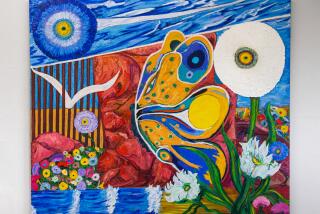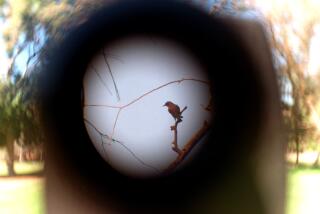Free Bird
- Share via
Imagine you are a wandering albatross. You are the largest of all flying birds, with wings that span more than 12 feet. You can walk on land; you can swim and dive, and you can fly, so you are numbered among the few creatures that are at home in all the elements that wild animals inhabit.
But it is your flying ability that sets you apart. You are the uncontested master of the air, able to fly and navigate for thousands of miles at a time and return unerringly to the island where you were born. You do not power your way through the air but glide on unseen air currents that no other creature on Earth understands and uses as well as you do. You are not migratory like the terns and shearwaters that fly from high northern to high southern latitudes every year, but you and your mate regularly travel halfway around the world in search of food for yourself and your chick.
In “Eye of the Albatross,” Carl Safina saves you the trouble of this imagining, tracking--as he does--Amelia, a female Laysan albatross who leaves her chick on Tern Island, a lonely outpost in the northwest Hawaiian chain, and flies purposefully across the North Pacific to find food for her nestling:
“An hour after Amelia leaves, the last visual trace of French Frigate Shoals falls away behind her. She makes no note of it--as you make no note of leaving sight of your house when you run an errand. She sees herself neither as heroic nor hard-working. Nor does she have any other abstract concept. She has only purpose to hunt and she is keenly aware of that. And like any animal, like us when we travel, she knows where she is relative to home. But she has no visual markers on the ever-shifting ocean. Her mental map is not like yours. Her brain contains a compass--yours doesn’t--and a clock as accurate as your internal clock, which she pays more attention to. And of course, she has those wings. Albatrosses usually spend 80 to 90 percent of their time at sea flying, day and night.”
Writers choose their subjects for myriad reasons; but in this case, the reason is obvious: Safina is in love with albatrosses. To him, they not only represent the magnificence of nature but are also, as the book’s subtitle tells us, “visions of hope and survival.”
The mythology of the albatross precedes Safina’s book. The poet Samuel Taylor Coleridge in “The Rime of the Ancient Mariner” pins the drama of this epic poem--the curse of the mariner--on the shooting of an albatross. Killing this bird was long rumored to result in a loss of wind and has become a symbol of inevitable misfortune. As penance for his crime, the mariner is condemned to wear the albatross tied from his neck, which would be most inconvenient, considering the bird’s enormous wingspan and a body that weighs 25 pounds.
But not all albatrosses are this large, nor is “Eye of the Albatross” about every species of the bird (and there are many species, most of which live in the Southern Hemisphere). Albatrosses in flight are heart-stoppingly beautiful, and they often follow ships in graceful swoops and soaring arcs, but to study them, researchers have to visit their remote islands. Safina pays closest attention to birds like Amelia and other Laysan and Black-footed albatrosses that nest in the mid-Pacific at breeding grounds like Tern Island.
All is not well, he reports, with albatrosses. Like many of the magnificent creatures of this planet, they have paid the price of mankind’s rapaciousness and environmental negligence. One species, known as the short-tailed albatross, is one of the rarest birds in the world, having been killed in astonishing numbers during the last century by Japanese plume hunters. (One of the greatest thrills I ever had was watching a short-tail circle our ship when we were sailing in the Kurile Islands, north of Japan, last year.)
Through Safina (and Amelia), we get a sense of the profound importance and interrelatedness of the world’s life forms. Naturalist Henry Beston was not writing of albatrosses, but he might as well have been when he wrote in “The Outermost House”:
“For the animal shall not be measured by man. In a world older and more complete than ours, they move more finished and complete, gifted with the extension of the senses we have lost or never attained, living by voices we shall never hear. They are not brethren, they are not underlings; they are other nations, caught with ourselves in the net of life and time, fellow prisoners of the splendor and travail of the earth.”
Safina’s writing is equal to the subject, and the subject is the most magnificent of all flying creatures, soaring, gliding, diving and hunting over the wide ocean, as sure of its destination as Safina is sure of the mot juste. About Amelia he writes, “When the wind returns, she sets her wings and, without anything perceivable as a bodily movement, continues for another hundred miles, flying in long undulations on the propellant energy of the breeze.”
Safina has become the poet laureate of things oceanic. In his previous book, “Song for the Blue Ocean,” he brought to our attention--painfully but beautifully--the plight of some of the world’s endangered fish. From the oceans’ depths, he now takes wing. In the albatross triumphant, Safina sees nothing less than the salvation of the planet.
*
From ‘Eye of the Albatross’
An albatross is a great symphony of flesh, perception, bone, and feathers, composed of long movements and set to ever-changing rhythms of light, wind, water. The almost overwhelming musicality of an albatross in air derives not just from the bird itself but from the contrapuntal suite of action and inaction from which this creature composes flight. It drifts in the atmosphere at high speed, but itself remains immobile--an immense bird holding stock-still yet shooting through the wind. Just as individual notes become music by relationship to other notes, the bird’s stillness becomes movement by context. Following your traveling ship with ease, watching you, circling stern to prow and back at will, it flies with scarcely a flinch, skimming wave upon wave, mile after mile. Watching it, you invariably wonder, How can it do that?
More to Read
Sign up for The Wild
We’ll help you find the best places to hike, bike and run, as well as the perfect silent spots for meditation and yoga.
You may occasionally receive promotional content from the Los Angeles Times.






